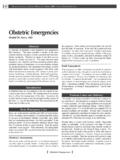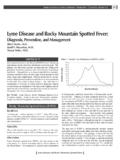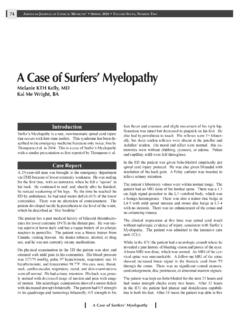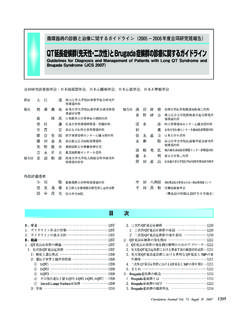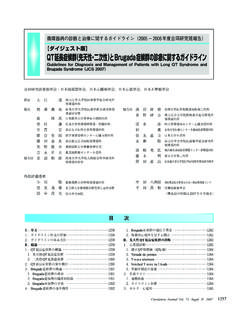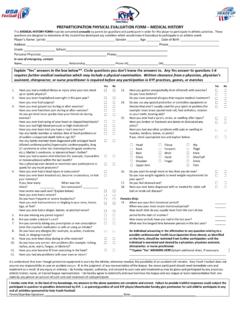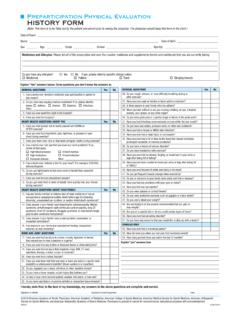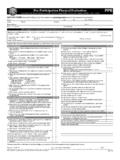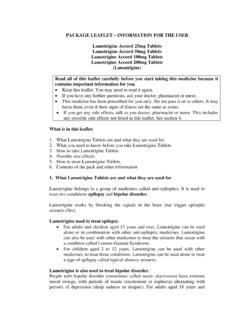Transcription of Evaluation of Syncope in the Emergency Department
1 American Journal of Clinical Medicine Winter 2010 Volume Seven, Number One 11. Evaluation of Syncope in the Emergency Department David M. Lemonick, MD, FAAEP, FACEP. Introduction Differential Diagnosis Syncope is a symptom complex composed of a transient loss The differential diagnosis of Syncope is extensive (Table 1). In of consciousness associated with an inability to maintain pos- addition, other Syncope -like conditions, such as seizure, stroke, tural tone, secondary to a brief decrease in cerebral blood flow and head injury, should be considered during the initial evalua- that spontaneously and completely resolves and that requires no tion of a patient with transient loss of consciousness. Seizures Accounting for 3% of Emergency Department may be difficult to distinguish from Syncope .
2 Seizure is sug- (ED) visits and 1% to 6% of all hospital admissions,2 Syncope gested by: a history of seizure disorder, an abrupt onset as- presents a challenge to Emergency practitioners: to differentiate sociated with head injury, tongue biting (particularly involving those patients safe for discharge from those who require emer- the lateral aspect of the tongue), the presence of a tonic phase gent Evaluation and in-hospital management for potentially preceding the onset of clonic activity, unusual posturing or head life-threatening etiologies. The precise cause of Syncope can deviation, loss of bladder or bowel control, age less than 45. be identified during the initial Evaluation in only 20% to 50% of years, medication noncompliance, a preceding aura, and pro- Of note, it is estimated that up to 80% of the causes longed confusion and disorientation after the of Syncope that are identified during a hospital admission are determined in the Emergency In contrast to seizure, Syncope is often preceded by sweating or nausea and by sitting or standing and has rapid return of orienta- While most potential causes of Syncope are benign and self- tion upon awakening.
3 Syncope more often occurs in patients limited, some etiologies are associated with significant morbid- older than 45 years, and it is associated with a history of conges- ity and mortality. Approximately 4% of patients discharged tive heart failure (CHF) and coronary artery disease (CAD). from the ED with Syncope return within 72 hours and are ad- mitted or Life-threatening causes of Syncope include cardiovascular causes, hemorrhage, and subarachnoid hemorrhage (SAH). A. Cardiac arrhythmias and sudden death are the chief short-term rule of 15s for Syncope reminds us that approximately 15% of complications to be avoided in Syncope . In one population- the following life-threatening conditions present with Syncope : based study, patients with cardiac causes of Syncope had double SAH, acute coronary syndrome (ACS), aortic dissection, leak- the mortality rate of patients without Syncope .
4 The average cost ing aortic aneurysm (AAA), and ruptured ectopic of care per hospital admission for Syncope is approximately $5,000, and more than $2 billion a year is spent in the United Many of the missed diagnoses of these five conditions that re- States on such The emphasis in the Evaluation sulted in medico-legal action involved presentations that includ- of the patient who presents to the ED with Syncope is on risk ed Syncope . The physician evaluating a patient with brief loss stratification and on doing so in an expeditious, cost-effective of consciousness should be vigilant for the possibility of carbon manner, and in a medico-legally defensible manner. This ar- monoxide toxicity, SAH, carotid dissection, vertebrobasilar ticle will attempt to simplify the clinical approach to the patient transient ischemic attack, leaking abdominal aortic aneurysm, with Syncope based upon the current literature.
5 Gastrointestinal hemorrhage, and ruptured ectopic pregnancy. Evaluation of Syncope in the Emergency Department 12 American Journal of Clinical Medicine Winter 2010 Volume Seven, Number One Table 1: Differential Diagnosis of Syncope NEURALLY-MEDIATED (REFLEX) CARDIOGENIC. Carotid sinus hypersensitivity Cardiac arrhythmia Head turning Amiodarone toxicity Circumferential neck compression (neck tie) Atrial fibrillation with Wolff-Parkinson-White syndrome Shaving Atrial flutter Atrial surgery Glossopharyngeal neuralgia AV block Idiopathic postural hypotension AV canal defects AV conduction system disease Peripheral neuropathy Sinus node dysfunction Alcoholic Supraventricular tachycardia Amyloid deposition Ventricular tachycardia Diabetes Pacemaker or automated internal cardiac defibrillator dysfunction Malnutrition Brugada syndrome Situational Catecholaminergic tachycardia Cough Long QT syndrome Swallow, defecation Structural cardiac obstructive lesions Micturition Acute coronary syndrome Post-exercise Aortic valve stenosis Post-prandial Atrial myxomas Others ( , brass instrument- Hypertrophic cardiomyopathy playing, weightlifting)
6 Cardiac tamponade Vasovagal (common faint) Aortic dissection Significant hemorrhage MEDICATION-RELATED. Trauma with significant blood loss Vasoactive medications Gastrointestinal bleeding Alpha and beta blockers Tissue rupture Calcium channel blockers Aortic aneurysm Nitrates Spleen Antihypertensive medications Ovarian cyst Diuretics Ectopic pregnancy Erectile dysfunction medications Retroperitoneal hemorrhage Medications affecting conduction Pulmonary embolism Antiarrhythmics Saddle embolus resulting in outflow tract obstruction or severe Calcium channel blockers hypoxia Beta blockers Digoxin Subarachnoid hemorrhage Medications affecting the QT interval Cerebrovascular Antiarrhythmics Vascular steal syndromes Antiemetics Antipsychotics/depressants Orthostatic hypotension Drug side effects Cardiovascular causes are the most common life-threatening
7 Dysautonomias conditions associated with Syncope , and these can be divided Multiple system atrophy Parkinson's disease into arryhthmogenic, structural, and Syncope from Postural orthostatic tachycardia syndrome a sudden disruption in cardiac output is the most deadly form Pure autonomic failure of Syncope . Arrhythmogenic causes of Syncope can include Shy-Drager syndrome ventricular tachycardia, long QT syndrome, Brugada syndrome, Volume loss bradycardia ( , Mobitz type II or 3rd degree heart block), and Autonomic dysfunction Deconditioning, prolonged bed rest significant sinus pauses ( , >3 seconds). Lyme disease is a cause of conduction defects that cause bradydysrrhythmia and that present as Syncope . Ischemia includes acute myocardial in- also known as neurally-mediated, vasovagal, and vasodepressor farction and coronary syndromes.
8 Among structural abnormali- Syncope , is a reflex-mediated bradycardia and hypotension that ties are: valvular heart disease, such as aortic or mitral stenosis, leads to a brief decrease in cerebral perfusion. Such episodes usually last less than 30 seconds and may be accompanied by cardiomyopathy ( , ischemic, dilated, hypertrophic), aortic tonic-clonic movements, known as brainstem release phenom- dissection, atrial myxoma, and cardiac tamponade. ena, or mycoclonus. In contrast to seizures, sphincter control is Non-life-threatening causes of Syncope include neurocardiogen- maintained in vasodepressor Syncope . Neurocardiogenic causes ic Syncope , carotid sinus hypersensitivity, orthostatic Syncope , of Syncope include micturition and defecation, cough, swallow- and medication-related Syncope .
9 Neurocardiogenic Syncope , ing, glossopharyngeal nerve, pain, heat, breath-holding, and situ- Evaluation of Syncope in the Emergency Department American Journal of Clinical Medicine Winter 2010 Volume Seven, Number One 13. ational. These events are due either to increased vagal tone or Table 2: Partial List of Drugs that Prolong the QT syndrome to inappropriately decreased sympathetic tone. Generic Brand Class/Clinical Use Medication effects are contributory in 5% to 15% of events, and Name Name many common medications can contribute to Syncope . These Anti-arrhythmic / abnormal heart Amiodarone Cordarone . include: alpha and beta blockers, antiarrhythmics, antihyper- rhythm tensive medications, antiemetics, antipsychotics, antidepres- Anti-arrhythmic / abnormal heart Amiodarone Pacerone.
10 Sants, calcium channel blockers, digoxin, diuretics, erectile rhythm dysfunction medications, nitrates, medications affecting con- Arsenic trioxide Trisenox Anti-cancer / leukemia duction and those prolonging the QT interval (Table 2).9 Astemizole Hismanal Antihistamine / allergic rhinitis QT prolongation is also associated with hypokalemia, hypo- Bepridil Vascor Anti-anginal / heart pain magnesemia, hypocalcemia, elevated intracranial pressure, Chloroquine Aralen Anti-malarial / malaria infection ACS, hypothermia, and hereditary causes. Alcohol is another Chlorpromazine Thorazine . Anti-psychotic/ anti-emetic /. substance that frequently contributes to Syncope . It will be not- schizophrenia/ nausea ed that many patients with Syncope are taking several classes of Cisapride Propulsid GI stimulant / heartburn these medications at the same time.
